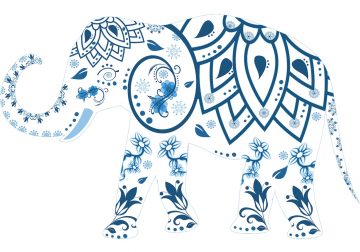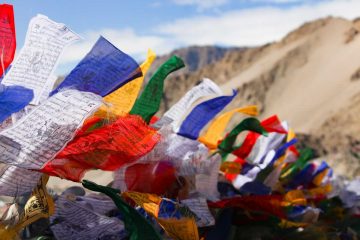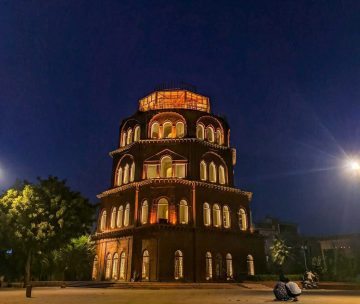The Taj Mahal is a delicate work of art which attracts thousands of visitors every day from around the world. Visiting the Taj Mahal is a must in everybody’s lifetime. The Mughal Emperor went to great lengths to ensure his love for his wife: it was immortalized with the construction of this mausoleum.
Talk Travel App has compiled a list of reasons why the Taj Mahal should be a part of everybody’s travel bucket list.
1. The reason behind the construction of the Taj Mahal
It was the Mughal Emperor Shah Jahan who commissioned the construction of this exquisite monument as an expression of his love to his dear wife Mumtaz Mahal.
Shah Jahan called her Mumtaz Mahal, meaning the ‘Beloved Ornament of the Palace’ or ‘Chosen One of the Palace’. Her actual name was Arjumand Banu Begum.
In the year 1631, Mumtaz Mahal, unfortunately, breathed her last while giving birth to their 14th child. Shah Jahan was so devastated with his loss, that he was inconsolable and was in deep grief at her demise. Shah Jahan decided to move the remains of his dead wife in 1631.
2. Construction of the Taj Mahal
Masons, stonecutters, inlayers, carvers, painters, calligraphers, dome-builders and other artisans came from the whole of the empire and also from Central Asia. The Taj Mahal was built in 22 years approximately. It used the work of around 22,000 laborers and 1,000 elephants. The construction finished in the year 1653 after an expenditure of approximately 32 million rupees.
Architectural style
The mausoleum of the Taj Mahal and the whole complex around it is a classic example of the Mughal style of architecture with the Islamic tomb as a prominent feature. There is a combination of Persian, Islamic and Indian architectural style in the construction.
What was the Taj Mahal made of?
The Taj Mahal mausoleum is made of bricks and white Makrana marbles from Rajasthan cover it.
The other important elements of the Taj monument are the Mosque and the Guest House. Both these complexes use bricks covered with red sandstone for its construction. The most noteworthy fact is that they are a replica of each other and hence symmetrical in design and in architecture. Consequently adding an aesthetic color contrast. The red sandstone was from Fatehpur Sikri.
This scale of construction also signifies the power and strength the Mughal Empire enjoyed those days. Shah Jahan under his rule was able to build a monument of this scale without any disturbances in the power circle or face any financial hurdles during its construction.
Mosiac work
The most astonishing fact of these is its intricate design. To achieve it, they used rare and semi-precious stones from far-flung areas. Apparently, Shah Jahan was very knowledgeable about those precious stones.
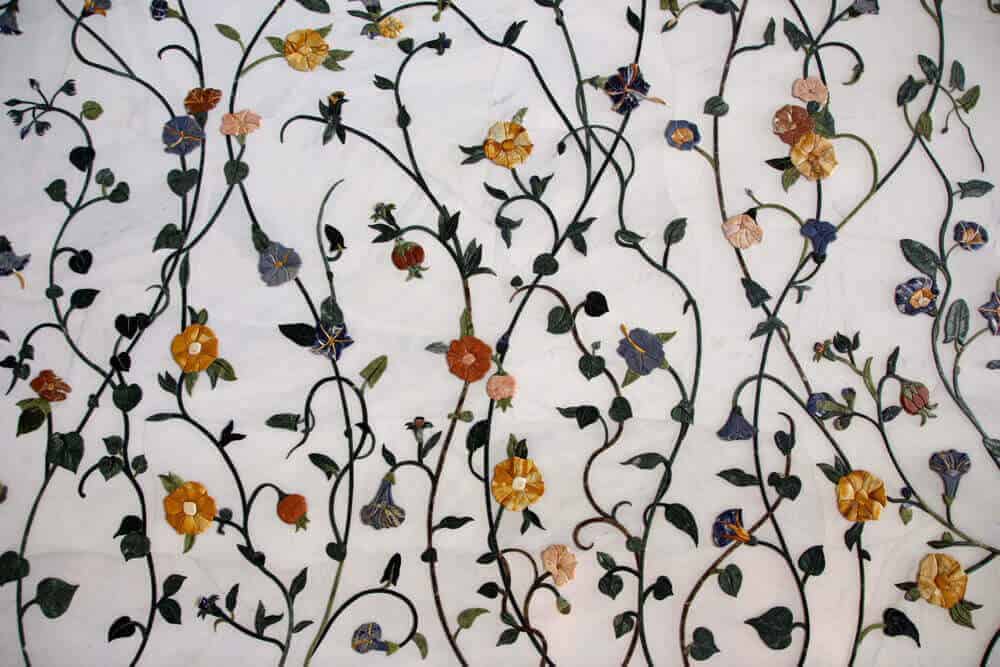
The floral motifs that adorn the walls of the Taj Mahal use a lot of rare and semi-precious stones. These were carefully embedded into the marble using the traditional Pietra Dura style of mosaic work. Parchin Kari is the name of this decorative art form using semi-precious stones.
This traditional art form is passed down through generations. There are artisans in Agra who continue to make this rock art at a smaller scale for souvenirs. A travel blogger took this special trip and has beautifully explained this delicate technique here accompanied by brilliant pictures on Core 77.
3. The architecture of the Taj Mahal
The Taj Mahal covers an area of 42 acres in total. Everything about the Taj Mahal, the two complexes flanking its sides, the garden, and the gateway are symmetrical. There was absolutely no room for error and the attention for detail in this aspect is worth an applause. The detailed history of the architecture can be read here.
3a. The Southern Gate or the main gateway
First of all, it is the main gateway that catches your glimpse when you finish the security check at the entrance. People call it Darwaza-i-Rauza or ‘gate of the mausoleum’ and it’s one of the main elements of this monument. It is also the South Gate which is, in fact, the main entrance to the Taj Mahal.

The gateway is made of bricks covered with red sandstone. There is Arabic calligraphy bordering the doorway which is nothing but quotes from the Quran calling the visitor to enter the Paradise Gardens. Black stone into white marble etches the quotes.
You can notice eleven little domes just above the entrance on the gateway. There is another set of eleven little domes on the other side of the gateway, totaling 22 little white domes. Therefore this signifies the precise number of years it took to construct the Taj Mahal.
As you walk past the Darwaza, you see the view you have been preparing for all this while. The white mausoleum perched on a plinth sparkling white at the end of the long watercourse and interspersed garden.
3b. Char Bagh or the Garden
The Char Bagh is a perfect 300 square meters in dimension. When you view the garden from above you can see its divided into 4 pieces by 4 calm water bodies. These 4 waterways represent the sea of water, wine, milk and honey which signify paradise as mentioned in the Quran. Each of the 4 sectors has 4 quadrants, making it a total of 16 pieces of the garden with lawn.
Recorded documents have mentioned that the Char Bagh garden was full of fruit-bearing trees, fragrant flowering plants thriving with life.
After many years, the surroundings were deteriorating and the then British Viceroy to India, Lord Curzon began restoring this monument. The trees were removed which made way for flat gardens and lawns for the first time. The grass accentuated the vista of the Taj Mahal and the waterways easily.
3c. Mosque on the Western Side
The mosque is on the left or the western side of the complex. Used for prayer purpose, the mosque faces the direction of the holy city of Mecca.
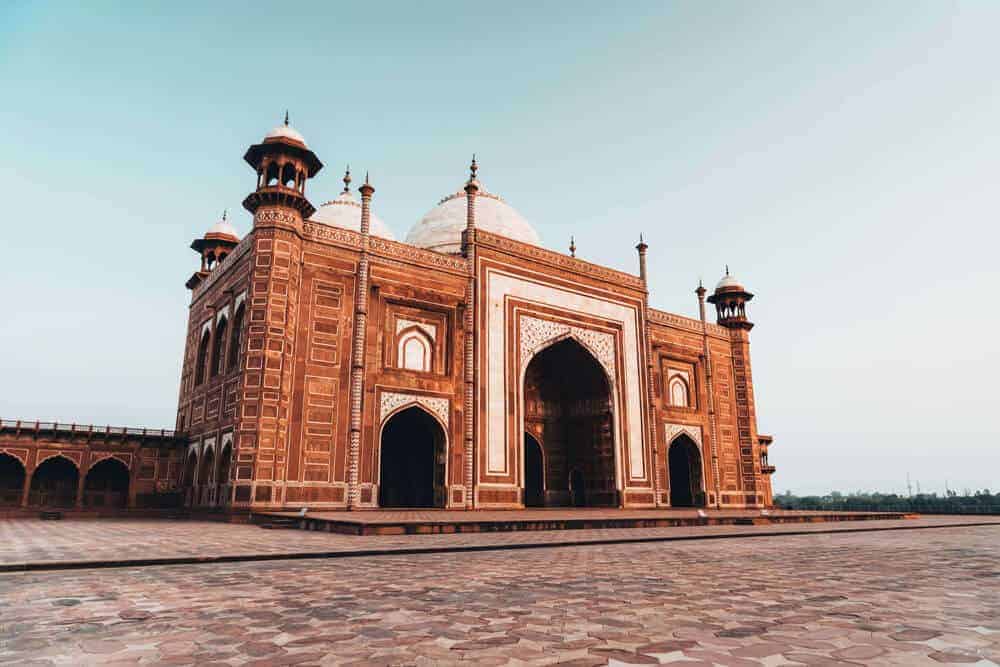
3d. The Guest House on the Eastern Side
People also call the guest house Naqqar Khana, Mihman Khana, or the Assembly Hall. It is located on the eastern side of the Taj. It seems like it was built to provide a ‘jawab’, which translates to ‘answer’, as it balances the architectural symmetry and harmony of the whole structure. The exact purpose of the guest house is still not clear though it could have been used to house pilgrims.
3e. The main mausoleum
The Taj Mahal means the ‘Crown of all Palaces’ in Persian. It stands 73 m tall, raising 7 m from the gardens on a plinth. Each minaret is 43 m high to emphasize the beauty of the spherical dome. The dome is the most spectacular feature of the monument, being 17.7 m in diameter for a height of the arc of 24.4 m. The shape of the dome is emphasized by four smaller domed chattris (umbrellas) placed at its corners.
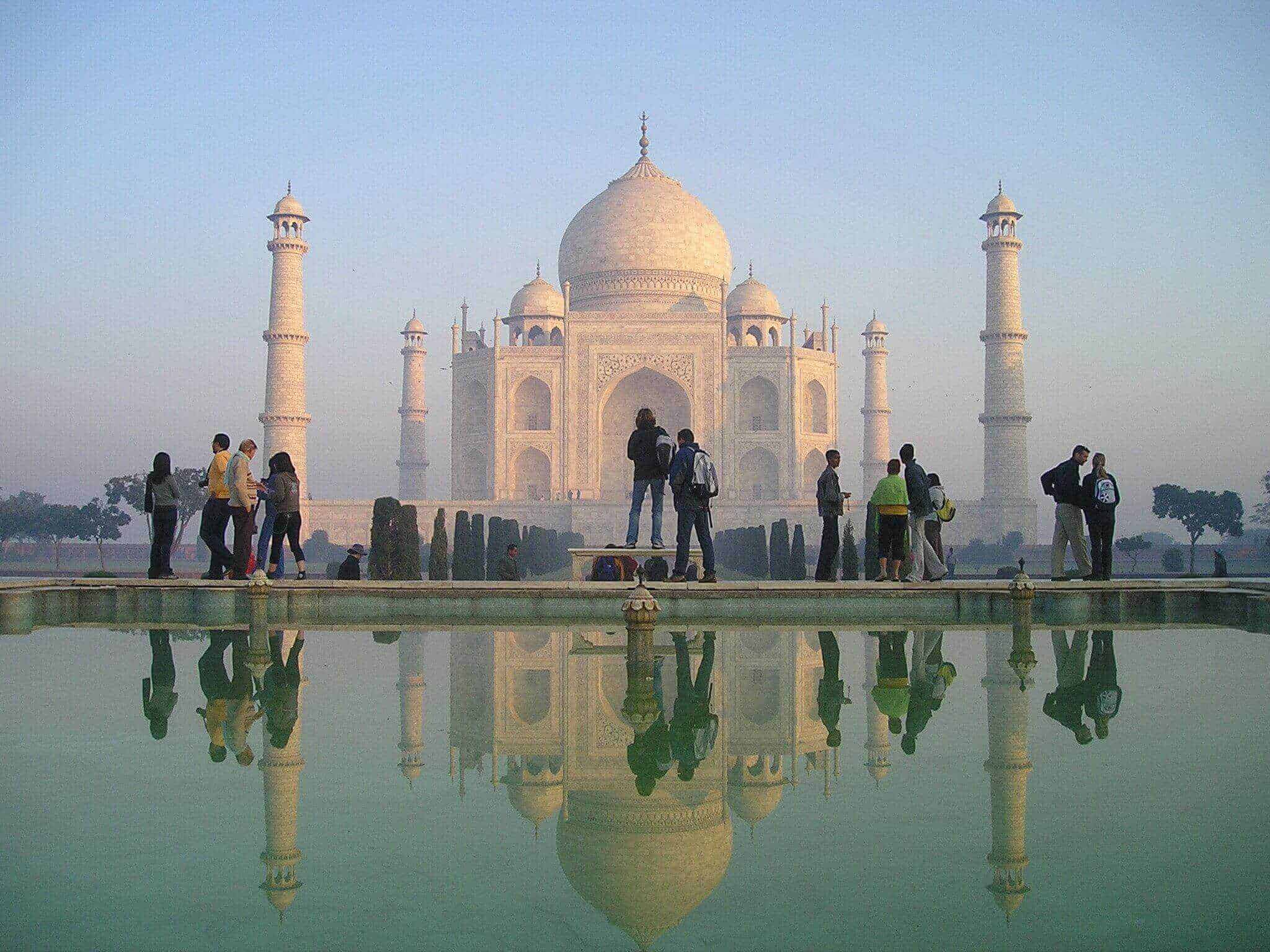
The four minarets at each corner of the Taj Mahal are not built at an exact 90° to the level of the ground, rather built a few degrees slightly outwards from the main dome. This is to avoid any structural damage to the main mausoleum if the minarets crashed in case of an earthquake or any such disaster.
The dome is topped by a brass finial, which mixes traditional Persian and Hindu decorative elements. The finial is topped by a moon, a typical Islamic motif, whose horns point towards heaven. Because of its placement on the main spire, the horns of the moon and the finial point combine to create the shape of a trident —reminiscent of the traditional Hindu symbols of Shiva. The exact design of the finial is drawn on the ground between the Taj Mahal and the Guest House.
3f. The interiors of the mausoleum
The interiors of the Taj Mahal have the cenotaphs of Shah Jahan and Mumtaz Mahal. The actual burial chambers of Shah Jahan and Mumtaz Mahal are under the ground just below the cenotaphs which are not in view. Visitors can’t access this place.
The cenotaph of Mumtaz Mahal is exactly in the center of the hall abiding by the rules of symmetry this monument strictly follows. When Shah Jahan died in 1666, his body was placed in a tomb next to that of Mumtaz Mahal on the western side. This clearly threw the symmetry of the entire monument off balance. Clearly, the grave and cenotaph were never meant to be there at all. It seems like his son Aurangazeb placed the cenotaph there upon his father’s death.
The most exquisite of any wall art that you can ever find is on display in the interiors and exteriors of the Taj Mahal. There is the very delicate marble screen or jali inlay which surrounds both the cenotaphs. This intricate design on the rock is equivalent to a fine piece of jewelry. It looks so fine that when you touch it, it feels like a painting. It’s difficult to believe they’re exotic stones!
3g. The lamp inside the mausoleum
There is a beautiful bronze lamp hanging from the roof on the inside of the dome above the cenotaphs. This bronze lamp inlaid with gold and silver was a special gift from Lord Curzon to the monument. It has Persian words engraved on it, which reads as ‘Presented to the Tomb of Mumtaz Mahal by Lord Curzon, Viceroy 1906’.
History has it that when Lord Curzon used to visit the Taj Mahal he was shocked and appalled to see dim and poorly lit lamps used inside the mausoleum. So he took it upon himself to find the best lamp to match this lavish beauty. In one of his journeys from India to London through Cairo, he met scholars and artisans to have a replica of the lamp that once hung from the mosque of Sultan Baibars I in Egypt.
Todros Badir, an experienced artisan, finished this masterpiece and it took almost two years to do it. This bronze lamp now hangs inside the mausoleum.
3h. The exteriors of the mausoleum
The mausoleum has four sides with chamfered corners. Each of these corners has pilasters with designs which make for good optical illusion. These pilasters have 4 sides, with the forth side attached to the wall. The remaining 3 sides are equal in length. They have V-shaped motifs stacked on the entire pilaster.
Try this trick when you are there – stand at least 3 meters away from the wall, fix your eyes at the V-shaped motif and walk closer. As you walk closer, look up slowly and you will seem to see six sides of the pilaster instead of three.
There are Quranic verses on the mausoleum, with Jasper inlaid into marble and has thuluth script. The texts refer to themes of judgment: of doom for nonbelievers, and the promise of Paradise for the faithful. Since there is a prohibition in Islam to depict any human or animal forms in religious art and architecture, you will find a lot of floral motifs in the design of this monument. You can see flowers, leaves, and wines carved out of plain marble in the interiors.
The Taj Mahal was built in stages. The plinth and the tomb took 15 years and the minarets, mosque, the guesthouse, and the gateway took an additional 5 years.
4. Photographing tips
The Taj Mahal is a photographer’s dream. Here are a few tips to bear in mind to get great shots of the Taj.
- You can’t make professional videos inside the complex. You need to take prior permission from the office of Archaeological Survey of India located at 22, Mall Road, Agra. If you are capturing a video for a blog, it should be fine.
- The first glimpse of the Taj Mahal is from the gateway: the Darwaza-i-Rauza. This is a great spot to click some fantastic pictures.
- As you walk past the main gateway, you will witness the Taj Mahal in its entirety.
- There is an elevation in front of the Taj Mahal, which people call the ‘Diana Bench’. The name has caught on since Princess Diana’s visit to the Taj Mahal.
- Walk to the right towards the Guest House. This structure is on the eastern side and hence with the sunrise behind you, the Taj Mahal from this viewpoint looks golden in color.
- Another interesting viewpoint of the main mausoleum is from the mosque on the western side. The silhouette of the dome and the final on top of the dome looks very prominent when you watch from the inside of the mosque.
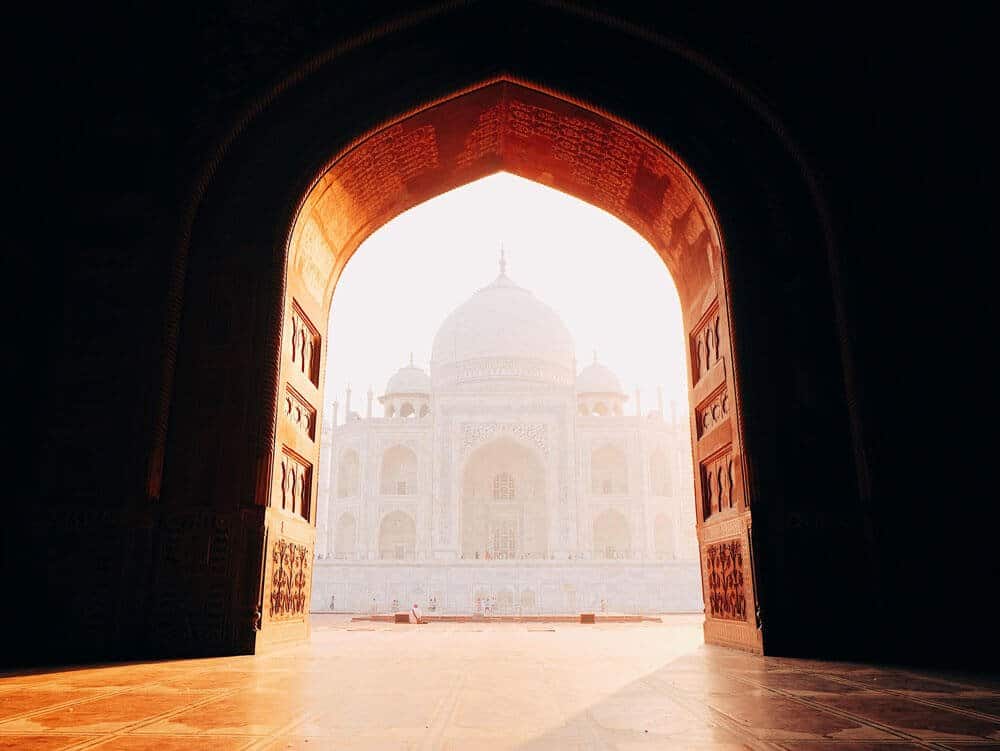
- With the river Yamuna flowing beside the Taj Mahal, go to the other side of the Taj Mahal which has the Mehtab Bagh garden: a great place to observe the symmetry and the whole complex. You can hire a rickshaw to go to Mehtab Bagh for a price of around 100 INR.

- The beauty of the Taj Mahal is exceptional during and around the full moon night.
- When you visit the Agra Fort, you can see the Taj Mahal at a distance.

5. Myths of the Taj Mahal
As if the story behind the construction of this monument wasn’t fascinating enough, there are a lot of unverified stories and myths about the Taj Mahal. If you want to read the origin of the myth and how they were debunked, read them in detail here.
Threats to the Taj Mahal
The Taj Mahal was built in the 17th century when the threat of pollution was unheard of. In the 21st century, the Taj is under serious threat from air and water pollution. With a lot of factories and vehicular pollution ruining the quality of the air, there is evidence that the soot from emissions is discoloring the flawless white shade of the marble on the Taj.
The foundation of the Taj Mahal kept in mind the water levels of the river Yamuna during the 17th century. In recent times, it has changed due to industrial waste and the mindlessly dumping of sewage into the river.
Certainly, this calls for special attention immediately and for the years to come. We only hope that the monument is safeguarded through sincere efforts from law enforcement agencies.
Do write to us, in case you have any questions and we at Talk Travel App are happy to help. If you need any help in building a travel itinerary or you have any other query, download our free Talk Travel App. It is available for download on your Android or iOS device. You can download the Talk Travel App for free and reach out to the local expert without any additional cost. You are free to ask any doubt before or during your travel to our local expert.
We wish you a safe and happy travel!
Are you traveling around India? You might want to look at the other guides and posts we have written for India, to make your travel more easy and enjoyable.


